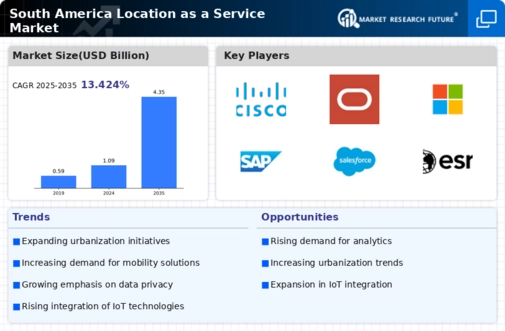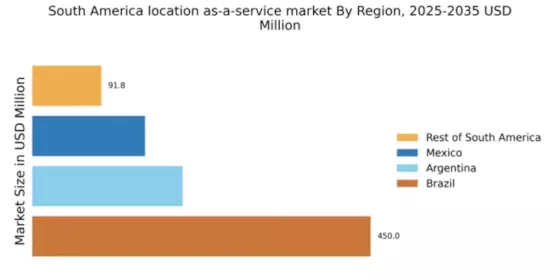Adoption of IoT Devices
The proliferation of Internet of Things (IoT) devices in South America serves as a significant catalyst for the location as-a-service market. As more devices become interconnected, the demand for location-based services that can track and manage these devices is on the rise. Industries such as agriculture, transportation, and healthcare are increasingly utilizing IoT solutions that rely on accurate location data for monitoring and analysis. For instance, smart agriculture practices that employ IoT sensors can optimize resource usage and improve crop yields. The market for IoT devices in South America is expected to reach $30 billion by 2027, suggesting a robust growth trajectory. This trend indicates that the location as-a-service market will likely benefit from the expanding ecosystem of IoT applications.
Rising Demand for Real-Time Data
The location as-a-service market in South America experiences a notable surge in demand for real-time data analytics. Businesses across various sectors, including retail and logistics, increasingly rely on accurate location data to enhance operational efficiency and customer engagement. This trend is driven by the need for timely insights that can inform decision-making processes. According to recent estimates, the market for real-time data solutions is projected to grow at a CAGR of approximately 15% over the next five years. This growth indicates a robust appetite for location-based services that can provide actionable intelligence. As organizations seek to optimize their supply chains and improve customer experiences, the location as-a-service market is poised to benefit significantly from this demand for real-time data.
Expansion of E-Commerce Platforms
The rapid expansion of e-commerce platforms in South America is a critical driver for the location as-a-service market. As online shopping continues to gain traction, businesses are increasingly leveraging location-based services to enhance their logistics and delivery operations. The convenience of tracking shipments and optimizing delivery routes is paramount for e-commerce success. Recent data suggests that e-commerce sales in South America are expected to reach $100 billion by 2025, highlighting the potential for location-based solutions to streamline operations. Companies are investing in technologies that enable them to provide accurate delivery estimates and improve customer satisfaction. Consequently, the location as-a-service market is likely to see substantial growth as e-commerce platforms integrate these services into their operations.
Increased Focus on Customer Experience
The location as-a-service market is increasingly driven by a heightened focus on customer experience across various sectors in South America. Businesses are recognizing the importance of personalized services that cater to individual preferences and behaviors. By leveraging location data, companies can tailor their offerings and marketing strategies to enhance customer satisfaction. For example, retailers can utilize geolocation to send targeted promotions to customers based on their proximity to stores. This approach not only improves engagement but also drives sales. As customer expectations evolve, organizations are likely to invest more in location-based solutions to meet these demands. The market for customer experience technologies is projected to grow by approximately 20% annually, indicating a strong correlation with the growth of the location as-a-service market.
Government Initiatives for Urban Development
Government initiatives aimed at urban development in South America significantly influence the location as-a-service market. Various countries are investing in infrastructure projects that incorporate smart technologies, which often rely on location-based services for effective implementation. For instance, urban planning efforts that utilize geospatial data can lead to more efficient public transportation systems and improved resource allocation. As governments allocate funds for these projects, the demand for location as-a-service solutions is expected to rise. Reports indicate that public sector investments in smart city initiatives could exceed $50 billion by 2026, creating a favorable environment for the location as-a-service market to thrive. This trend underscores the importance of collaboration between public and private sectors in advancing urban development.


















Leave a Comment